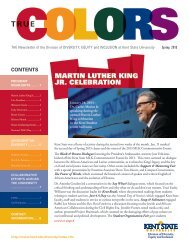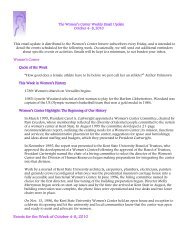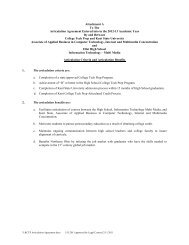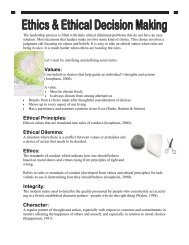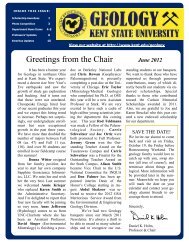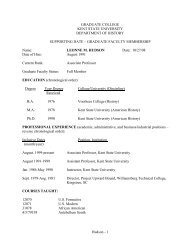Lester Lefton Lester Lefton - Kent State University
Lester Lefton Lester Lefton - Kent State University
Lester Lefton Lester Lefton - Kent State University
Create successful ePaper yourself
Turn your PDF publications into a flip-book with our unique Google optimized e-Paper software.
Bending the<br />
Laws of<br />
Physics<br />
Researchers receive $5.5 million to study<br />
new optical material<br />
By Melissa Edler, ’00<br />
The idea that the focusing power<br />
of optical elements comes from<br />
their shape and how light bends<br />
at the surface has been around<br />
since the first century. It wasn’t<br />
fully explained, however, until<br />
the 17th century, when physicists<br />
developed a theory behind<br />
the phenomenon and predicted<br />
that when electromagnetic<br />
radiation, such as light, passes<br />
between two media — like<br />
from air to water — it bends or<br />
refracts at a positive angle or to<br />
the right side.<br />
Today, this rule, named<br />
Snell’s law, applies to every optical<br />
object, including traffic lights,<br />
headline ticker boards, microscopes,<br />
telescopes, camcorders<br />
and cameras.<br />
Recently, though, scientists<br />
have discovered a new type of<br />
material called negative index<br />
materials (NIMs), which defy<br />
Snell’s law by bending light in<br />
the opposite direction. “These<br />
metamaterials are rewriting the<br />
laws of optics, because they bend<br />
light in a left-handed direction<br />
compared to their positive, righthanded<br />
counterparts,” says Dr.<br />
Oleg Lavrentovich, director of<br />
<strong>Kent</strong> <strong>State</strong> <strong>University</strong>’s Liquid<br />
Crystal Institute®.<br />
<strong>Kent</strong> <strong>State</strong> researchers,<br />
along with a team of scientists<br />
from several other institutions,<br />
received a $5.5 million Multidisciplinary<br />
<strong>University</strong> Research<br />
Initiative (MURI) last April<br />
from the Air Force Office of Scientific<br />
Research to study these<br />
unique metamaterials.<br />
The notion of negative index<br />
materials was considered wildly<br />
speculative and unrealizable<br />
when it was proposed more than<br />
30 years ago. Recently, however,<br />
scientists have learned how to<br />
create NIMs in spectra invisible<br />
to the human eye.<br />
As part of a five-year MURI<br />
project, <strong>Kent</strong> <strong>State</strong> researchers<br />
and their colleagues plan to<br />
break new ground by creating a<br />
negative index material for the<br />
visible and near-infrared spectrum<br />
of light.<br />
The concept of a material<br />
with sub-wavelength resolution<br />
is revolutionary in the fields of<br />
science and technology. “The optical<br />
behavior of negative index<br />
materials is astonishing, and it<br />
opens the door to a wide variety<br />
of new and exciting applications,”<br />
says Dr. Peter Palffy-Muhoray,<br />
a <strong>Kent</strong> <strong>State</strong> professor of chemical-physics<br />
at the Liquid Crystal<br />
Institute and principal investigator<br />
of the project.<br />
Lenses made from NIMs,<br />
which are not found anywhere<br />
in nature, have unique physical<br />
properties. A lens made from<br />
negative index materials could<br />
have resolution that is unlimited<br />
by wavelength. In addition, these<br />
metamaterials could reverse the<br />
Doppler effect, potentially creating<br />
zero reflectance from objects.<br />
Photograph by G a r y H a r w o o d , ‘ 8 3<br />
Dr. Peter Palffy-Muhoray is principal investigator on the project to study<br />
negative index materials.<br />
These negative index materials<br />
have the potential to improve<br />
devices in communications,<br />
electronics, optics and medicine.<br />
Specific applications include<br />
creating flat, apertureless imaging<br />
elements; “perfect” lenses<br />
with super resolution; nondestructive<br />
optical tweezers to<br />
manipulate biological cells;<br />
novel antennas; new beam<br />
steering devices; sensors; novel<br />
band gap materials; high-density<br />
optical storage; vast improvements<br />
to Magnetic Resonance<br />
Imaging (MRI) scanning; and<br />
the ability to store more information<br />
on products such<br />
as DVDs.<br />
For more information about<br />
this research, visit www.kent.<br />
edu/magazine.<br />
p a g e12<br />
6<br />
2




